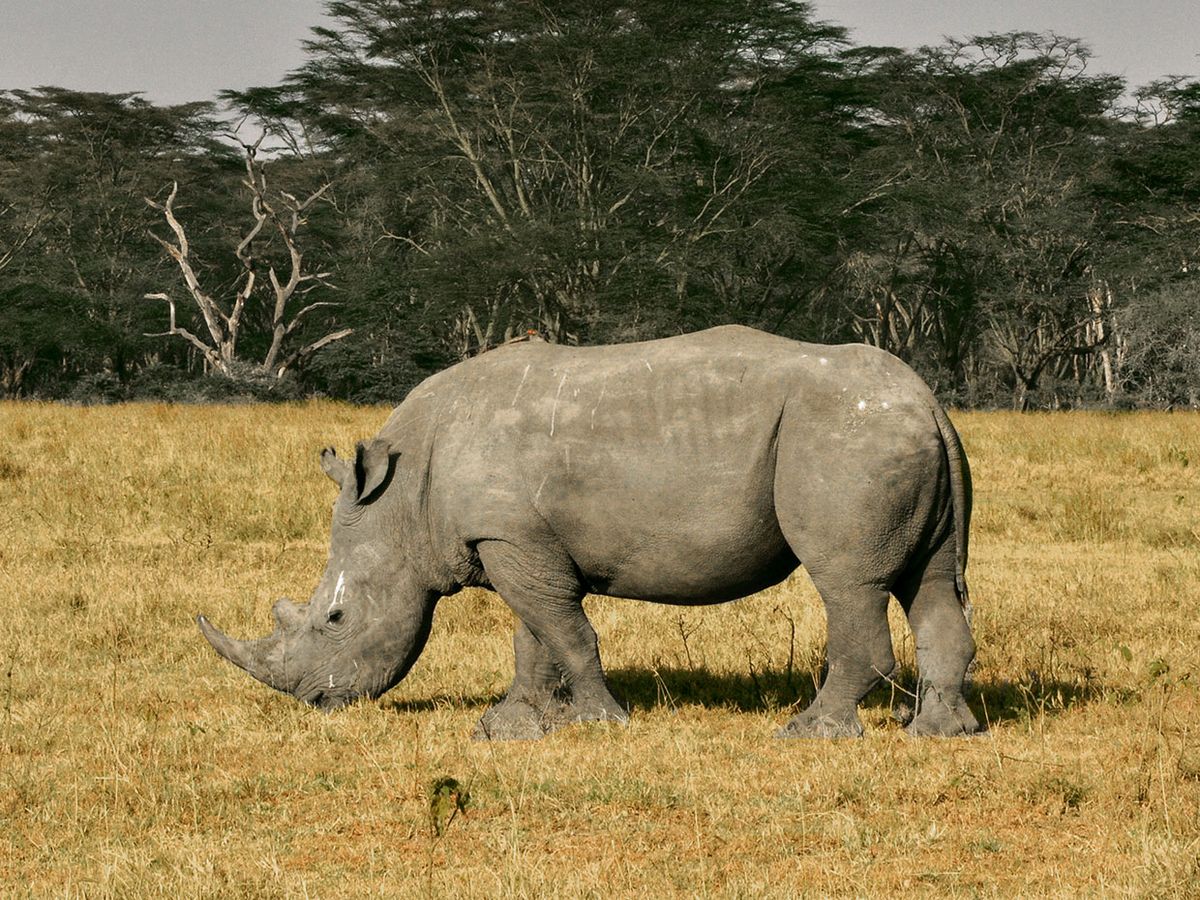THE INSTITUTEThe illegal poaching of black rhinoceroses in Africa, like the one above, has helped to decimate their population, from about 65,000 in the 1970s to just 5,400 today. Black rhinos are one of the world’s most endangered species, according to the World Wildlife Fund (WWF). The animals are being killed for their horns, which can fetch thousands of U.S. dollars per kilogram on the black market.
The African Wildlife Foundation estimates that the global wildlife poaching trade generates up to $23 billion annually in illicit revenue.
Most of Africa’s remaining rhinos are found in four countries: Kenya, Namibia, South Africa, and Zimbabwe. Housed in wildlife preserves and national parks, they are protected by armed rangers. Some of the locations span hundreds of kilometers, and the poachers often outnumber and outgun the rangers.
There were 769 rhino poaching incidents in South Africa last year, the national Department of Environmental Affairs says.
To help combat poaching and improve ranger safety, the WWF and sensor maker FLIR Systems teamed up in January to launch the Kifaru Rising project. In Swahili, the word for rhino is kifaru. FLIR pledged more than $3 million worth of thermal-imaging technology, engineering assistance, and training.
WWF conservation engineer Eric Becker, an IEEE member, is the project’s lead engineer. Kifaru Rising aims to eliminate rhino poaching in Kenya by 2021 with the help of thermal-imaging security cameras.
IMPROVED DETECTION
The project calls for installing FLIR cameras at 10 parks and game reserves in Kenya to secure the park’s perimeters and help rangers identify illegal intrusions.
“We can’t save rhinos if we don’t stop poaching,” Carter Roberts, president and CEO of the WWF, said in a news release about the collaboration. “New technologies help change the game. They give rangers a leg up in deterring criminals and protecting themselves on the front lines of this war.”
Thermal imaging can detect radiation in the electromagnetic spectrum and produce images of that radiation.

Using handheld thermal-imaging cameras and ones mounted on patrol vehicles [shown above], and checking ones on poles located around the parks’ perimeters, rangers can scan an area up to 3 kilometers away and see the heat generated by a human or other animal, Becker says.
“What most people don’t realize is that everything glows around you and the frequency of that glow is the spectrum emission,” he says. “We can deploy a sensor that can look out into the environment and really pick up on the living things that emit heat that the ranger can’t see.
“The reason that thermal imaging is good for monitoring the parks is that it provides that contrast. Those infrared-detector elements create a detailed temperature pattern, called a thermogram, which is displayed on the camera.”
The fixed-mounted thermal cameras that workers plan to place around the 10 parks’ borders are capable of generating real-time video that can be streamed to control rooms so armed rangers can be deployed when an intruder is detected.
FLIR infrared cameras that the WWF installed in other parks are reducing poaching, Becker reports. One is a reserve that borders Nakuru, Kenya. It has a road that provided poachers with quick access to congregating rhinos, making the animals easier targets. After poachers saw that cameras had been installed along the park’s fence and learned of arrests being made, they stopped going there, Becker says.
“Rangers used to dread being deployed to that park, because they were almost always guaranteed to get into shootouts with the poachers,” Becker says. “Now they have peace of mind because they no longer have that stress. It’s psychological but, by installing the cameras, we have taken that area away from poachers.”
WILDLIFE-LOVING ENGINEERS NEEDED
When Becker joined the WWF in 2016, he was the first conservation engineer the organization had ever hired. He previously worked as an engineering contractor for a variety of organizations including the U.S. Defense Advanced Research Projects Agency, a U.S. Air Force research lab, and the Army’s Special Forces. His background in military projects gave him a familiarity with security systems.
IEEE got him into the conservation field, he said, after a chance meeting he had in 2014 with a WWF representative who gave a presentation at an IEEE event in Washington, D.C., about how drones and robots could be used to benefit society.
“WWF realized the value of having that type of engineer in-house—someone who had a really deep understanding of the technology, who knew what was out there and what would work, but also could bring that technical background to a team that was knowledgeable about the issues but who were not necessarily technologists,” he says.
The WWF could afford to hire him, he adds, in part thanks to a $5 million grant it received from Google in 2012 to fund high-tech monitoring of endangered species.
Part of Becker’s job is to visit wildlife preserves and work with the experts on the ground—including rangers, other researchers, park managers, and community leaders—to understand their challenges.
“I need to articulate those challenges into engineering requirements,” he says, “because engineers speak requirements. Then I either develop my own solutions or use off-the-shelf technology that will work in these environments. This is a better use of my skill set and a lot more in line with what I love to do.”
He says he’s one of the few engineers working on technologies to protect wildlife. “It’s really a shame there are not more engineers going into this field,” he says. “There should be a million more like me working to save animals.”
To that end, Becker and others have created the conservation technology website, Wildlabs.net, where conservationists on the ground can post their challenge and engineers can offer solutions.
“There are plenty of areas where engineers who are interested in this type of work can get involved and actually make a meaningful impact,” he says. “We need plenty of creative engineers and computer scientists, because we are just scratching the surface of ways technology can help.”
